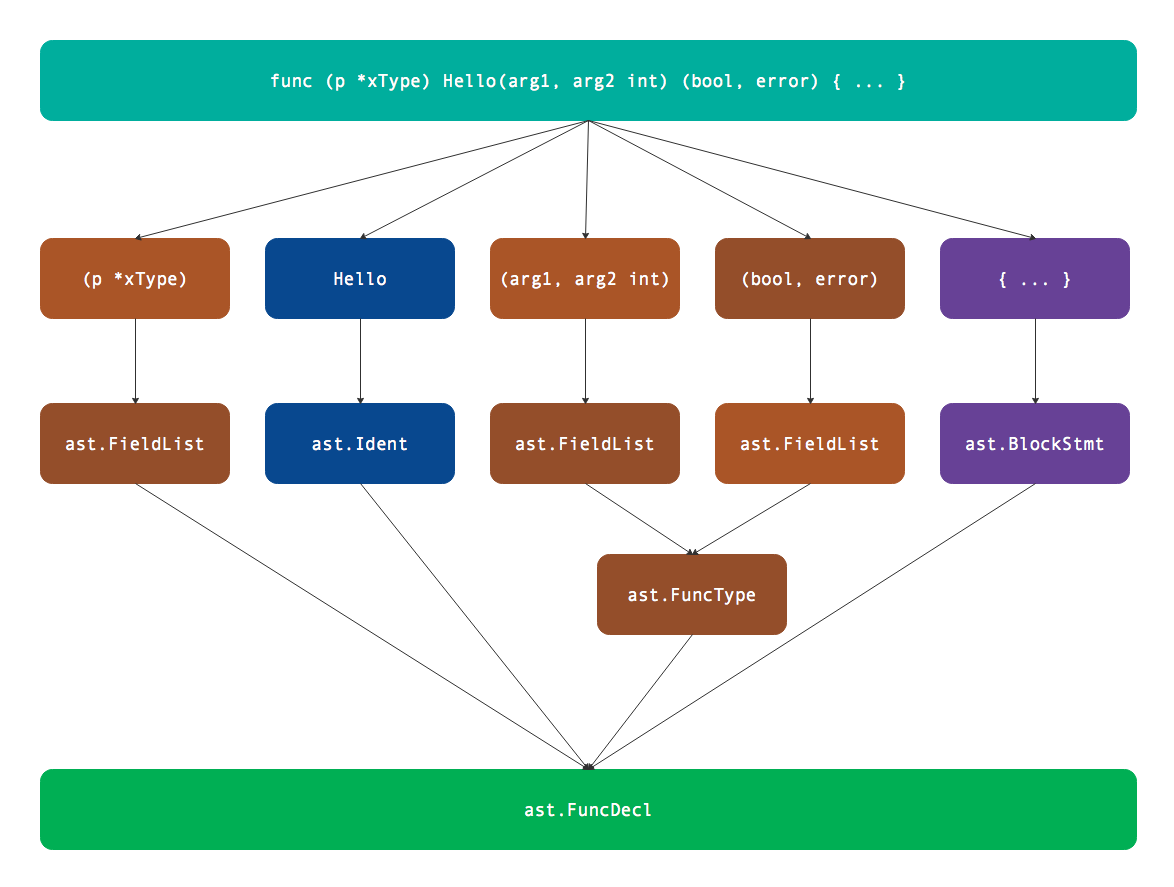- 凹语言(Go实现, 面向WASM设计): https://github.com/wa-lang/wa
- WaBook(Go语言实现的MD电子书构建工具): https://github.com/wa-lang/wabook
第6章 函数声明
函数是所有编程语言中的核心,因为只有函数的语句才有了计算的功能。Go语言的函数也是一种值数据,可以定义包级别的函数,也可以为自定义的类型定义方法,同时还可以在局部作用域内定义闭包函数。本节将讨论函数的数据类型。
6.1 函数的语法
在顶级声明中包含函数和方法的声明,从语法角度看函数是没有接收者参数的方法特例。函数的语法规则如下:
FunctionDecl = "func" MethodName Signature [ FunctionBody ] .
MethodDecl = "func" Receiver MethodName Signature [ FunctionBody ] .
MethodName = identifier .
Receiver = Parameters .
Signature = Parameters [ Result ] .
Result = Parameters | Type .
Parameters = "(" [ ParameterList [ "," ] ] ")" .
ParameterList = ParameterDecl { "," ParameterDecl } .
ParameterDecl = [ IdentifierList ] [ "..." ] Type .
其中FunctionDecl表示函数,而MethodDecl表示方法。MethodDecl表示的方法规范比函数多了Receiver语法结构,Receiver表示方法的接收者参数。然后是MethodName表示的函数或方法名,Signature表示函数的签名(或者叫类型),最后是函数的主体。需要注意的是函数的签名只有输入参数和返回值部分,因此函数或方法的名字、以及方法的接收者类型都不是函数签名的组成部分。从以上定义还可以发现,Receiver、Parameters和Result都是ParameterList定义,因此有着相同的语法结构(在语法树中也是有着相同的结构)。
6.2 定义函数
包一级的函数只有包函数和方法两种类型(闭包函数只能在函数体内部创建),而包函数可以看作是没有接收者的方法函数。因此只有搞明白方法函数的类型,全局的包函数自然就清楚了。
下面是一个方法函数:
func (p *xType) Hello(arg1, arg2 int) (bool, error) { ... }
通过parser.ParseFile解析得到*ast.File类型的f返回值之后,可以通过以下的代码打印方法的声明:
for _, decl := range f.Decls {
if fn, ok := decl.(*ast.FuncDecl); ok {
ast.Print(nil, fn)
}
}
函数的声明对应*ast.FuncDecl类型,它的定义如下:
type FuncDecl struct {
Doc *CommentGroup // associated documentation; or nil
Recv *FieldList // receiver (methods); or nil (functions)
Name *Ident // function/method name
Type *FuncType // function signature: parameters, results, and position of "func" keyword
Body *BlockStmt // function body; or nil for external (non-Go) function
}
其中Recv对应接收者列表,在这里是指(p *xType)部分。Name是函数的名字,这里的名字是Hello。而Type表示方法或函数的类型(函数的类型和接口的定义一致,因为接口并不包含接收者信息),其中包含输入参数和返回值信息。最后的Body表示函数体中的语句部分,我们暂时忽略函数体部分。
函数声明最重要的是名字、接收者、输入参数和返回值,其中除名字之外的三者都是ast.FieldList类型,而输入参数和返回值又被封装为ast.FuncType类型。表示函数类型的ast.FuncType结构体定义如下:
type FuncType struct {
Func token.Pos // position of "func" keyword (token.NoPos if there is no "func")
Params *FieldList // (incoming) parameters; non-nil
Results *FieldList // (outgoing) results; or nil
}
其中Params和Results分别表示输入参数和返回值列表,它们和函数的接收者参数列表是相同的类型。因此该方法的定义可以用下图表示:

对于没有接收者的包函数,ast.FuncDecl.Recv部分为nil。而对于方法函数,即使定义多个接收者参数依然是可以正确解析的。因此合法的语法树不一定完全满足Go语言的规范,一般在语法树构建完成之后还需要专门进行语义分析。
6.3 参数分组
接收者、输入和返回值参数均由ast.FieldList定义,该结构体定义如下:
type FieldList struct {
Opening token.Pos // position of opening parenthesis/brace, if any
List []*Field // field list; or nil
Closing token.Pos // position of closing parenthesis/brace, if any
}
type Field struct {
Doc *CommentGroup // associated documentation; or nil
Names []*Ident // field/method/parameter names; or nil
Type Expr // field/method/parameter type
Tag *BasicLit // field tag; or nil
Comment *CommentGroup // line comments; or nil
}
ast.FieldList其实是[]*ast.Field切片类型的再次包装,注意是增加了开始和结束的位置信息。每一个ast.Field表示一组参数,所有参数的名字由[]*ast.Ident切片表示,而通一组参数有着相同的类型。Type表示一组参数的类型,是一个类型表达式。
查看下面的例子:
func Hello1(s0, s1 string, s2 string)
其中s0省略了类型,和s1共享string类型,因此s0和s1是一组参数,对应一个ast.Field。而s2是另一个独立的ast.Field。
函数的接收者、输入和返回值参数均可以省略名字,如果省略了名字则使用后面第一次出现的类型。如果全部参数都省略了名字,那么每个参数就只有类型信息,函数体内部无法再通过参数名字访问参数。